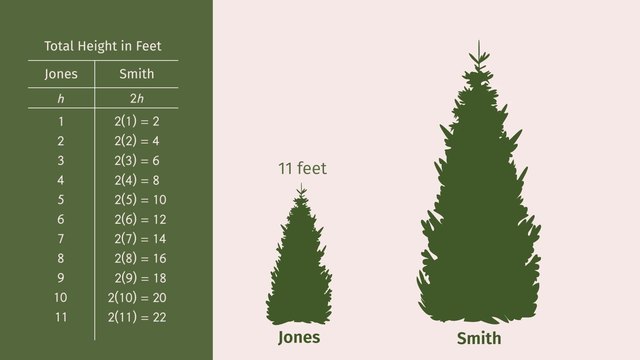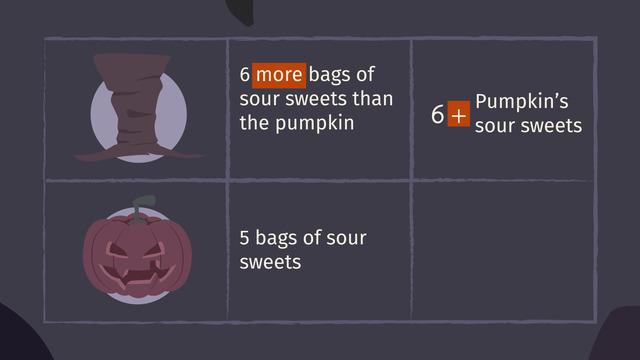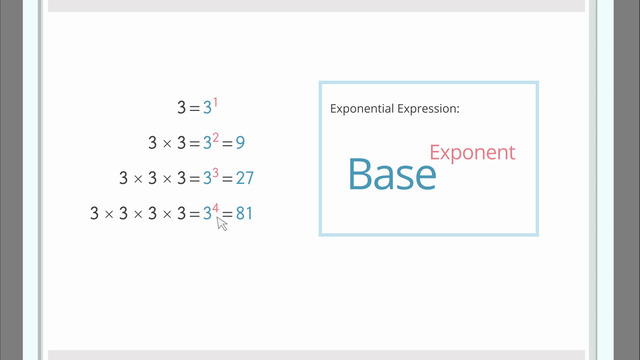Writing and Evaluating Expressions with Multiplication and Division


Basics on the topic Writing and Evaluating Expressions with Multiplication and Division
Evaluating a word problem requires the ability to translate words into their corresponding mathematical expressions. Coupled with the ability to recognize specific keywords to identify operations, like multiplication or division, writing the correct expression will enable an accurate solution to the word problem at hand. Learn how to write and evaluate expressions with multiplication and division by helping the Smiths beat the Joneses in the annual holiday decoration contest.
Common Core Reference: CCSS.MATH.CONTENT.6.EE.A.2
Transcript Writing and Evaluating Expressions with Multiplication and Division
It’s December 1st, and the neighbors on Winter Way have started decorating for the holidays. Everyone on the block is very excited. Especially the Smith family. Will this finally be the year the Smiths win for best neighborhood decorations? For ten years running, the Joneses have had the best decorations on the block. This year, the Smiths don't want to simply keep up with the Joneses, they want to beat them. To do that, the Smiths will need to know about Writing and Evaluating Expressions with Multiplication and Division. So, what’s their big plan? The Smith's daughter, Polly the Problem Solver, has made a list of steps. Step 1 on the list is to buy a Christmas tree. The Smiths think bigger is better, so they plan to get a tree that is 2 times the size of the Jones’s tree. But, there's a problem, the Smiths don’t know the size of the Jones’s tree. Let's make a table to help Polly. We already know that we can use a variable to represent an unknown quantity. Since our unknown quantity is the height of the Jones's tree, let's let 'h' represent the height, in feet, of the Jones's tree. The Smiths want a tree that is 2 times ‘h’. We can write this quantity in algebraic terms as: 2h. Notice how we dropped the multiplication sign? If you have a coefficient in front of a variable it already means times, so when writing algebraic terms, we won’t write the multiplication symbol, but we still know we're multiplying. If 'h' is equal to 1, then 2h is equal to 2. If 'h' is equal to 2, then 2h is equal to 4, and so on, and so on and so on. Will you look at the Jones’s tree!? It must be 11 feet tall! If we fill out the chart until 'h' equals 11. 2h would equal 22. To have a tree that will be two times the size of the Jones’s tree, the Smiths will need to buy a tree that is 22 feet tall. 22 feet tall!!! Oh boy! Now the Smiths need to get started on the next item on Polly's list: to have 4 times as many twinkling lights as the Joneses, plus 200 special snowflake-shaped lights. There is a slight problem with Polly's list. Just like with the tree, the Smiths don’t know how many twinkling lights the Joneses will have. Let's make another table to help Polly. Polly picks the variable ‘L' to represent the unknown number of lights displayed on the Jones' house. 4L represents part of Polly's wish: to have 4 times the number of lights on the Jones's house, and don't forget to add the 200 snowflake shaped lights. So, the expression to describe the total number of lights on the Jones's house is 4L + 200. Polly counts the twinkling lights on the Jones’s house. There are exactly 1,000 lights! Instead of filling out the table until 'L' equals 1,000, we can save time and let L equal 1,000 in the expression 4L+200. If we plug this in to our equation, we see that her family will need 4,200 lights altogether to best the Joneses. 4,200 lights? That’s a lot of lights. Oh look, it’s snowing! But there's no time to play because we still have one more decoration to put up. Polly's list includes candle lights for the windows. As far as they know, the Joneses don't have any candles for their windows. The Smith's have 5 windows in their house and want to know how many candles they can put in each window. Using another table, let 'c' represent the number of candles they have, so 'c' divided by 5 represents how many candles per window. If they have 5 candles, the Smiths can put one candle in each window. If they have 10 candles, they can put 2 in each window. If they have 15 candles, they can put 3 in each window. If they have 20 candles, they can put 4 in each window, and so on. Let's drop in on the Smiths to look at the finished product. Oh no! Looks like it's lights out on Polly's idea!
Writing and Evaluating Expressions with Multiplication and Division exercise
-
Walk through the steps of picking a variable, setting up an expression, and completing a table.
HintsKeep keywords for multiplication in mind:
- times
- each
- per
- twice
- doubled
- tripled
So twice indicates multiplication.
Let's have a look at an example: Paul has double as much money as Anne. Anne has $4$ dollars. So, Paul has $8$ dollars.
SolutionLet's start with the unknown height of the Jones' tree. Usually we assign a variable to an unknown value. Often the letter $x$ is used as a variable. You can also use any letter; let's use the variable $h$ for the unknown height.
Next, we transform the word problem into an algebraic expression. The twice indicates multiplication. We have to multiply $h$ by $2$. This leads to $2h$ as the height of the Smiths' tree.
Last we can complete the table by multiplying each given height by $2$.
-
Complete the table using the correct expression.
HintsLet's have a look at the following example: the total number of candles is $40$. So the number of candles per window is $8$.
The following are some keywords for division:
- quotient
- split
- per
- every
- divide
- ratio
- each
evenly divide indicates division.
SolutionFirst, we figure out the operation we need to use: it's division.
The unknown number of candles, $c$, should be divided evenly between the $5$ windows. So you have to divide $c$ by $5$: $\frac c5$.
With this algebraic expression you can determine the number of candles per window, given the number of candles:
- $c=5$ $\rightarrow$ $\frac55=1$
- $c=10$ $\rightarrow$ $\frac{10}5=2$
- $c=15$ $\rightarrow$ $\frac{15}5=3$
- $c=20$ $\rightarrow$ $\frac{20}5=4$
-
Complete the table to find the expression.
HintsYou get a voucher of $25$ cents per bottle returned.
per indicates multiplication.
$25$ cents is a quarter of a euro; $25$ cents $=$ $0.25$ euros.
If you want to know the number of returned bottles, divide the total sum by $0.25$.
Let's have a look at an example.
If you get $50$ euro back, then you've returned
$\frac{50\text{ euros}}{0.25\text{ euros}}=200$
bottles.
SolutionLet $b$ be the number of returned bottles. So $0.25b$ determines the value of the voucher.
The other way round: for a given voucher, $v$,
$\frac{v}{0.25}=4v$
gives you the corresponding number of bottles.
You can see all the solutions beside.
Let's have a look at a view values:
- $b=10$ leads to $(10)(0.25)=2.50$
- $b=325$ leads to $(325)(0.25)=81.25$
$\frac{100}{0.25}=(4)(100)=400$.
This is the desired number in the last row.
-
Determine the wanted values.
HintsThe answer depends on the desired information:
What is given? The number of lawns or the amount of money earned?
Use division to solve the task given a certain amount of earned money.
For example, if Leo mows $12$ lawns, then he earns $180$ dollars. If he would like to earn $105$ dollars, then he should mow $7$ lawns.
SolutionBeside you see the whole solution.
Let's start with the algebraic expression.
Leo gets $15$ dollars for each lawn. Let $l$ be the variable for the number of lawns he mows. So we have to multiply: $15~l$.
With this information you get amount of money Leo earns, depending on the number of lawns he mows:
- $l=3$ leads to $(15)(3)=45$ dollars.
- $l=6$ leads to $(15)(6)=90$ dollars.
$\begin{array}{rcl} 15\times l & = & ~195\\ \color{#669900}{\div 15} & &\color{#669900}{\div 15}\\ l & = & ~13 \end{array}$
So Leo has to mow $13$ lawns to earn $195$ dollars.
-
Evaluate the expression $4l+200$ for the given $l$ values.
HintsIf you have to evaluate a given algebraic expression, just plug the value in for the variable.
Here you see an example with the algebraic expression $2h$ and $h=20$.
You see $h$ is replaced by $20$.
SolutionIf you'd like to evaluate this algebraic expression for different values for $l$, just replace $l$ by the values:
- $l=2$ leads to $(4)(2)+200=8+200=208$
- $l=5$ leads to $(4)(5)+200=20+200=220$
- $l=10$ leads to $(4)(10)+200=40+200=240$
- $l=15$ leads to $(4)(15)+200=60+200=260$
-
Express the word problem as an expression and evaluate.
HintsDecide which operation to use first.
For this, keep keywords for multiplication or division in mind.
You can check each result. For example, if Paul buys tacos for $250$ dollars, at $5$ dollars each, he has to divide, $\frac{250}5=50$, to get the number of tacos.
The other way round, Paul multiplies to see how much money he will spend in total: $50\times 5=250$ dollars.
SolutionIf Zoe earns $m$ per year, you can calculate the monthly income by dividing by $12$: $\frac m{12}$.
For a given income of $36,000$ dollars per year, we get $\frac{36000}{12}=3000$ dollars.
The total amount of concert tickets sold is $m$. If each ticket costs $75$ dollars, how can we determine the number of sold tickets? It is $\frac m{75}$.
Let $m= 93,750$. To get the number of sold tickets, we have to divide $m$ by $75$: $\frac {93,750}{75}=1250$. This is the desired number of sold tickets.













